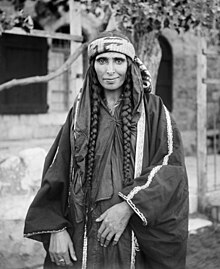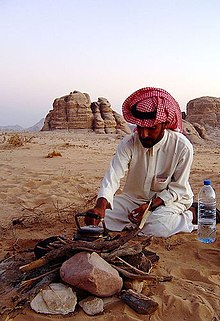| Revision as of 08:30, 12 June 2008 edit58.111.207.95 (talk)No edit summary← Previous edit | Revision as of 10:54, 12 June 2008 edit undoDoug Weller (talk | contribs)Edit filter managers, Autopatrolled, Oversighters, Administrators264,172 editsm Reverted good faith edits by 58.111.207.95; Rv failed attempt to rewrite lead. (TW)Next edit → | ||
| Line 1: | Line 1: | ||
| ]]] | ]]] | ||
| The '''Bedouin''', (from the ] ''{{ArabDIN|badawī}}'' ({{lang|ar|بدوي}}), pl. ''badū''), are a |
The '''Bedouin''', (from the ] ''{{ArabDIN|badawī}}'' ({{lang|ar|بدوي}}), pl. ''badū''), are a desert-dwelling ] ], or previously ] group, found throughout most of the desert belt extending from the Atlantic coast of the ] via the ], ], and ] to the ]. Non-Arab groups as well, notably the ] of the ]n coast of the ] are sometimes called Bedouin. | ||
| ==Traditional Bedouin cultures<blockquote></blockquote>== | ==Traditional Bedouin cultures<blockquote></blockquote>== | ||
Revision as of 10:54, 12 June 2008

The Bedouin, (from the Arabic Template:ArabDIN (بدوي), pl. badū), are a desert-dwelling Arab nomadic pastoralist, or previously nomadic group, found throughout most of the desert belt extending from the Atlantic coast of the Sahara via the Western Desert, Sinai, and Negev to the Arabian Desert. Non-Arab groups as well, notably the Beja of the African coast of the Red Sea are sometimes called Bedouin.
Traditional Bedouin cultures

The Bedouins were divided into related tribes. These tribes were organized on several levels - a widely quoted Bedouin saying is "I and my brothers against my cousins, I and my brothers and my cousins against the world." The saying signifies a hierarchy of loyalties based on closeness of kinship that runs from the nuclear family through the lineage, the tribe, and even, in principle at least, to an entire ethnic or linguistic group (which is perceived to have a kinship basis). Disputes are settled, interests are pursued, and justice and order are maintained by means of this organizational framework, according to an ethic of self-help and collective responsibility *(Andersen 14). The individual family unit (known as a tent or bayt) typically consisted of three or four adults (a married couple plus siblings or parents) and any number of children.

When resources were plentiful, several tents would travel together as a goum. These groups were sometimes linked by patriarchical lineage but just as likely linked by marriage (new wives were especially likely to have male relatives join nealogies to take in new members).
The largest scale of tribal interactions is of course the tribe as a whole, led by a Sheikh (literally, "elder"). The tribe often claims descent from one common ancestor — as mentioned above, this appears patrilineal but in reality new groups could have genealogies invented to tie them in to this ancestor. The tribal level is the level that mediated between the Bedouin and the outside governments and organisations.
Bedouins traditionally had strong honor codes, and traditional systems of justice dispensation in Bedouin society typically revolved around such codes. The bisha'a, or ordeal by fire, is a well-known Bedouin practice of lie detection. See also: Honor codes of the Bedouin, Bedouin systems of justice
Bedouins are well known for practicing folk music, folk dance and folk poetry. See also: Bedouin music, Ardha, Ghinnawa
More in-depth discussions on these topics can be found in Chatty (1996) and Lancaster (1997).
Changing ways of life
Starting in the late 19th century, many Bedouins under British rule began to transition to semi-nomadism. In the 1950s as well as the 1960s, large numbers of Bedouin throughout the Middle East started to leave the traditional, nomadic life to settle in the cities of the Middle East, especially as hot ranges have shrunk and population levels have grown. In Syria, for example, the Bedouin way of life effectively ended during a severe drought from 1958 to 1961, which forced many Bedouin to give up herding for standard jobs. Similarly, government policies in Egypt and Israel, oil production in Libya and the Persian Gulf, as well as a desire for improved standards of living, effectively led most Bedouin to become settled citizens of various nations, rather than stateless nomadic herders.
Government policies pressuring the Bedouin into in some cases have been executed out of a desire to provide services (schools, health care, law enforcement and so on - see Chatty (1986) for examples), but in others have been based on the desire to seize land traditionally roved and controlled by the Bedouin.
Partial list of Bedouin tribes and populations

There are a number of Bedouin tribes, but the total population is often difficult to determine, especially as many Bedouin have ceased to lead nomadic or semi-nomadic lifestyles (see above) and joined the general population. Below is a partial list of Bedouin tribes and their historic place of origin:
- Abbadi tribe found in Jordan.
- al-Ajman, eastern Saudi Arabia and the Gulf States
- alatwy tribe (also known as Beni Ateyah), live in northwestern part of Saudi Arabia, Tabuk province.
- Al Bin Ali
- Al Buainain
- Al Bu Romaih
- Al-Matheel Also spelt Mathil, a prominent Yemeni tribe based in the Damt region of Yemen, most have spread to the capital Sana'a
- al-Awazem, mostly located in Kuwait, with a small section in northeastern Saudi Arabia.
- Aniza, Some Anizes are of Bedouin tribes that lives in northern Saudi Arabia, western Iraq, the Gulf States, and the Syrian steppe.
- Bani Hajer (AlHajri) large and powerful tribe in Saudi Arabia and the eastern Gulf States
- Bani Rasheed in Saudi Arabia, Kuwait, Egypt, Sudan, Eritrea, and North Africa.
- Bani Khalid, a large tribe spanning Saudi Arabia, Bahrain, Qatar, Oman, Kuwait, UAE, Jordan, Syria, Iraq and other countries. Its said they are the descendants of prophet Mohammeds companion "Khaled ibn Al-Waleed".
- Bani Truf in Ahwaz which is located in southwest of Iran near Iraqi border.
- Banu Yam centered in Najran Province, Saudi Arabia.
- Beni Sakhr in Syria and Jordan.
- al-Da'ajah Bedouin of Balqawi Amman in Jordan
- al-Duwasir, south of Riyadh, and Kuwait
- Ghamid, large tribe from Al-Bahah Province, Saudi Arabia. Mostly settled, but with a small bedouin section known as Badiyat Ghamid.
- Gil, A people group of Morocco; about 41,000 people.
- Harb, a large tribe, centered around Medina, but also extending northwards towards Tabuk and eastwards towards Al-Qassim.
- Hareeb 100 Miles South of Marib in Yemen
- Howeitat in Wadi Araba, and Wadi Rum, Jordan
- Hajaya in al-Qatarneh, and al-Hasa, Jordan
- Al Jalahma
- Juhayna, a large tribe, many of its warriors were recruited as mercenaries during World War I by Prince Faisal. It surrounds the area of Mecca, and extends to Southern Medina
- Khawalid in Jordan, Israel, Palestinian territories, and Syria.
- Tuba-Zangariyye, Israel near Syria
- Al Mannai
- al-Mawasi, a group living on the central Gaza Strip coast.
- Dulaim, a large tribe in Al Anbar western Iraq.
- al-Massaed tribe found in Jordan.
- al-Murrah in Saudi Arabia
- Al Muhannadi
- Murad, a tribe living 150 miles south-east of the capital of Yemen.
- Mutair, estimated at about 1,200,000 members; they live in the Nejd plateau, also, many families from the Mutair tribe live in the Gulf States, especially Kuwait.
- Muzziena in Dahab and South Sinai.
- Al Nuaim
- Negev Bedouins in Israel.
- al-Rashaydah, a large international tribe, originally centered around Medina, Saudi Arabia and Kuwait but also extending in Jordan, Egypt, Eritrea, Sudan, Libya and Mali, see also Bani Rasheed
- Rwala, a large clan from the Aniza tribe, live in Saudi Arabia, but extend through Jordan into Syria and Iraq, in the 1970s, according to Lancaster, there were 250,000-500,000 Rwala
- al-Qatarneh Bedouin of Balqa Amman in Jordan
- Shammar in Saudi Arabia, central, and western Iraq.
- Subay', central Nejd, and Kuwait
- Ubeidah, 150 miles west of the capital of Yemen
- Utaybah large tribe in western and central Saudi Arabia.
- Yahia, A people group of Morocco; about 96,000 people.
- Zaab, a small tribe which live with the Al-Ajman, in eastern Saudi Arabia.
- Zahran, large tribe from Al-Bahah Province, Saudi Arabia.
- Riyalat, a large strong family lived through out the years and now their place is salt (a city in Jordan) in the mean time and it's said that they came from the hejaz (Saudi Arabia now)some say that this family comes from the largest arabic tribe called as eenize ((عنزي))in arabic.
Notes
- www.joshuaproject.com
- Info on Tuba from Flags of the World Website
- www.joshuaproject.com
References
- Alush, Zvi. "New town for rich US immigrants: New southern town aims to attract affluent American immigrants" YNet 05.02.06
- Andersen, Roy R., Robert F. Seibert, Jon G. Wagner.Politics and Change in the Middle East: Sources of Conflict and Accommodation. Eighth edition. Upper Saddle River, NJ: Pearson Prentice Hall. 2007.
- Brous, Devorah. "The 'Uprooting:' Education Void of Indigenous 'Location-Specific' Knowledge, Among Negev Bedouin Arabs in Southern Israel;" International Perspectives on Indigenous Education. (Ben Gurion University 2004)
- Chatty, D Mobile Pastoralists 1996. Broad introduction to the topic, specific focus on women's issues.
- Chatty, Dawn. From Camel to Truck. The Bedouin in the Modern World. New York: Vantage Press. 1986
- Cole, Donald P. "Where have the Bedouin gone?". Anthropological Quarterly. Washington: Spring 2003.Vol.76, Iss. 2; pg. 235
- Falah, Ghazi. “Israeli State Policy Towards Bedouin Sedentarization in the Negev,” Journal of Palestine Studies, 1989 Vol. XVIII, No. 2, pp. 71-91
- Falah, Ghazi. “The Spatial Pattern of Bedouin Sedentarization in Israel,” GeoJournal, 1985 Vol. 11, No. 4, pp. 361-368.
- Gardner, Ann. "At Home in South Sinai." Nomadic Peoples 2000.Vol.4,Iss. 2; pp. 48-67. Detailed account of Bedouin women.
- Lancaster, William. The Rwala Bedouin Today 1981 (Second Edition 1997). Detailed examination of social structures.
- S. Leder/B. Streck (ed.): Shifts and Drifts in Nomad-Sedentary Relations. Nomaden und Sesshafte 2 (Wiesbaden 2005)
- Lithwick, Harvey. "An Urban Development Strategy for the Negev’s Bedouin Community;" Center for Bedouin Studies and Development and Negev Center for Regional Development, Ben-Gurion University of the Negev, August 2000
- Manski, Rebecca. "THE SCENE OF MANY CRIMES: SUFFOCATING SELF-SUBSISTENCE IN THE NEGEV;" News From Within, Vol. XXIV, No. 13, April 2006
- Manski, Rebecca. "Bedouin Vilified Among Top 10 Environmental Hazards in Israel;" News From Within, Vol. XXII, No. 11, December 2006
- Manski, Rebecca. "A Desert Mirage: The Rising Role of US Money in Negev Development" News From Within Vol. XXII No.8 October/November 2006
- Mohsen, Safia K. The quest for order among Awlad Ali of the Western Desert of Egypt.
- Thesiger, Wilfred (1959). Arabian Sands. ISBN 0-14-009514-4 (Penguin paperback). British adventurer lives as and with the Bedu of the Empty Quarter for 5 years
External links
- Introduction to Bedouin culture
- The Bedouin: Culture In Transition
- Bedouin Culture in Dahab, Sinai
- The Beduin of Arabia
- The Bedouin, Qatar
- Bedouin Culture & Folklore
- The Bedouin Nomads
- Sinai Bedouin Women
- Historic images of Bedouins from 1890-1920 from the American Colony Photography Department
- Fuchsia a seven-minute documentary about Bedouin girls.
- On Africans in the Naqab
- Center for Bedouin Studies and Development of Ben-Gurion University
- Bedouin photography
- The Negev Bedouin, A Photographic Exhibit
- UNRECOGNIZED Photo Exhibition: Stories of unrecognized villages, by Tal Adler
- Neohasid Jewish organizing against Blueprint Negev
- BUSTAN Jewish-Bedouin NGO which first broke the story on the Blueprint Negev
- BUSTAN: Resources on Negev Health and Environment
- BUSTAN Naqab Desert Socio-Environmental Timeline
- BUSTAN: Resources on Negev Development